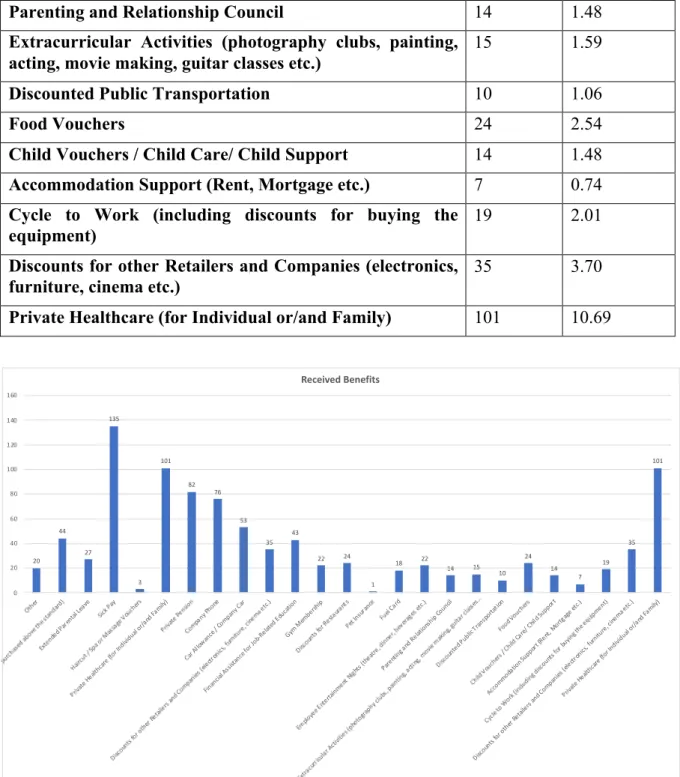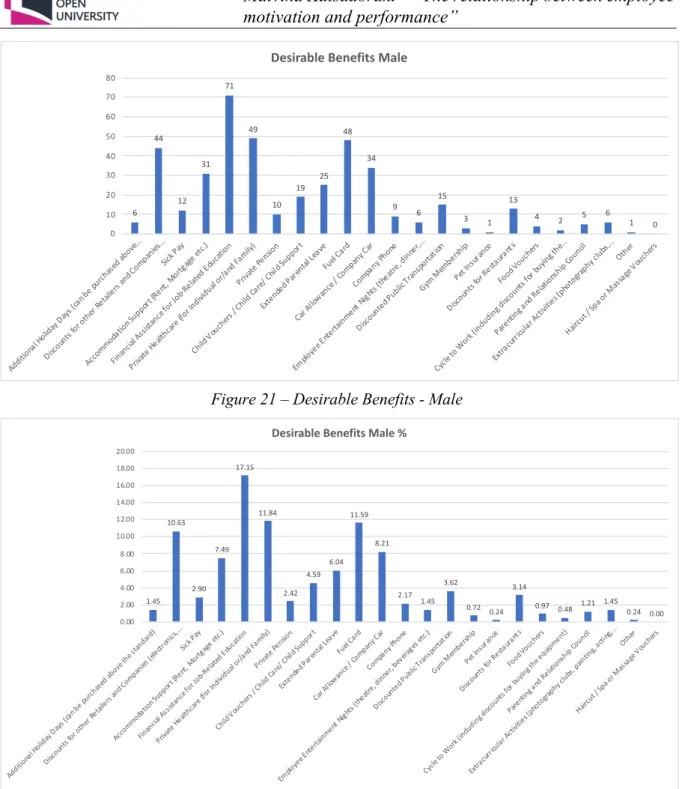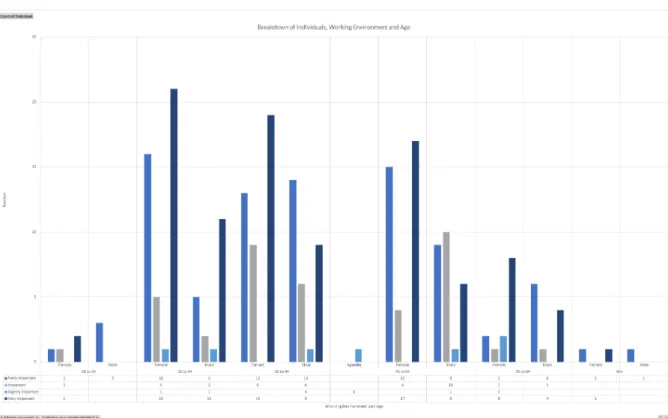The contents of this thesis/dissertation together with its results are owned by the Hellenic Open University and its author, where each of them has the sole and exclusive right to use, reproduce and publish it (in whole or in part) for educational or research purposes, with the obligation to refer to the thesis title, the author's name and to the Hellenic Open University where the thesis/dissertation was written. Employees who lack motivation will not perform well in their roles and since the employee performance is strongly related to the organization's profits, it can negatively affect the company's finances and reputation. This study is very important for all organizations as it will see the best motivation methods for all employees depending on their group and give a good understanding to improve their performance and loyalty to the organization.
Background
Challenge Statement
Companies are looking for people who embrace the mission of the company as their own. For a company to grow and achieve its targets, it is very important to have loyal individuals working for them, who will learn the job and not leave the company to join a competitor. Human resource departments must respect and adapt their employee management strategies accordingly to have happy, motivated employees who will in turn become more efficient, productive, loyal and committed in the way they work.
Objectives
This introduces a certain complexity in trying to manage every individual, in every country, in the same way while expecting the same result.
Methodology
Significance of the study
Organisations Used for the Study
There are several published studies, theories and surveys focused on employee satisfaction, motivation and loyalty. Many of these studies were conducted as part of university-led dissertations, but others were conducted and funded by the organizations themselves. This proves that the employee satisfaction, motivation and loyalty as a subject is very important for the organizations and does not remain only within the boundaries of the academic world.
Theory of Motivation
- Introduction to Motivation
- Abraham Maslow – Hierarchy of needs
- Frederick Herzberg – Two Factor Motivation
- David McClelland – Learned Needs
- Clayton Alderfer – Existence, Relatedness and Growth
- Douglas McGregor – Theory X and Theory Y
In the second group he categorized people whose dominant characteristic is the need for affiliation. According to Clayton, relatedness is the sense of trust, belonging and respect that an individual seeks. The first is the authoritarian style (Theory X) and the second is the participative style (Theory Y).
Main motivation factors in an organisation
- Salary
- Recognition
- Personal Growth
- Working Environment
- Benefits in kind
Training the employees has many benefits for the organization itself in addition to motivating the employees. Employees are able to work remotely, and organizations that offer such flexibility are becoming increasingly desirable as telecommuting contributes to employees' work-life balance. Benefits in kind or fringe benefits are benefits given to employees that are not in the form of wages.
Performance
- Performance monitoring
- David Holman’s performance monitoring features
- Performance monitoring techniques
- Campbell’s substantive factors of performance
Some of the benefits in kind, such as private pensions, may be required by law in many countries. This can be a great motivator for the employee to increase their performance in order to be promoted and receive a higher category vehicle (Dawson, 2016). According to David Holman, performance monitoring can be categorized based on three functions, the content, the purpose and the cognition (Holman, et al, 2002).
Employee Loyalty
- Allen and Meyer’s three component model
- Michael O’Malley’s five component model
- Reasons behind Turnover
- Relationship between employee loyalty and age
Initiative, persistence and effort is the factor that shows, with observation, an individual's above and beyond performance. Maintaining staff discipline is the factor that shows how well the individual has not expressed any negative behavior. Facilitation of peer and team performance is the factor that indicates the degree to which the individual was supported within his work environment.
Hiring new employees can be a challenge, as employees who want to have a career will avoid organizations with a bad reputation (Reddy, 2016). Associative commitment can be described as the feeling of pride or self-esteem in working in a particular organization. Moral obligation or normative commitment, similar to Allen and Mayer's theory, is the sense of obligation an employee feels towards their employer.
Affective commitment, also similar to Allen and Mayer's theory, is the sense of satisfaction an employee gets from working in a particular place and organization. The work-related factors can be any reason related to the work environment as a whole. This could be the job satisfaction someone might get, or their compensation, or even their working environment (facilities, management etc).
An example of an external factor that can affect an employee is the country's unemployment, which can be a result of war or even natural disasters etc.
Quantitively Methodology
Targeted Sample
Questionnaire
Questionnaire Questions
- What is your age?
- What is your gender identity?
- In what country do you currently work?
- Approximately, how many years have you been working in your current sector?
- For the position you have, how satisfied are you with employee recognition? . 26
- For the position you have, how satisfied are you with your working environment
- For the position you have, how satisfied are you with your work/life balance
- For the position you have, how satisfied are you with the company's culture
- For the position you have, how satisfied are you with the company's benefits
- For the position you have, order what is most important to you in your job (Very
- What Benefits do you currently receive from your Company?
- Please select the five most important benefits to you
This question was of interest to discover any patterns of motivation and satisfaction based on years of experience in the specific sector. This question attempted to gather information about whether the individual was satisfied with their current compensation. This is a very important question, since the salary is one of the main motivators for an employee.
However, someone more senior is expected to give a lot of value in the salary that a job will offer. This question attempted to capture other motivational factors offered by the organization but not in the form of compensation. Since every organization offers different packages of benefits in kind, this question is useful to determine if the employees are generally satisfied with the fringe benefits they receive in their current role and organization.
The data could then be aggregated and analyzed by gender, work location and age group. This question was posed as a matrix and listed the main motivational factors for employees. The last question of the questionnaire was to gather information about what individuals consider important to them.
As the survey participants worked in different countries, it would be good to note that some of the benefits listed in the survey are required by law in some countries and for some people they may not be considered benefits.
Demographic Results
- Age Groups of the sample
- Gender Identity of the Group
- Work Locations of the Sample
- Breakdown of Individuals Gender & Age
The second highest percentage came from Greece at 18.7% and the third highest percentage came from the United States at 11.75%. Due to limited responses from other countries, it will be difficult to examine the results for them. The graph above shows an overall representation of the breakdown of all survey participants based on their gender and age.

Received Benefits
- Received Benefits – Female
- Received Benefits – Male
- Received Benefits – England
- Received Benefits – Greece
- Received Benefits – USA
Child vouchers / childcare / child allowance 14 1.48 Accommodation support (rent, mortgage, etc.) 7 0.74 Bike to work (including discounts when buying . equipment). Discounts to other retailers and businesses (electronics, furniture, movie theater, etc.) Financial assistance for job-related training. Discounts for other retailers and businesses (electronics, furniture, cinema, etc.) Private healthcare (for individuals and/or family).
Additional vacation days (can be purchased above the standard) Discounts to other retailers and companies (electronics, furniture,. Bike to work (including discounts when purchasing the equipment) Discounts to other retailers and companies (electronics, furniture,. The least common benefit among women is Pet Insurance with 0.19%, Accommodation Support and Haircut/ Spa or Massage Vouchers both with 0.57%.
Child vouchers / child care / child support 4 1.10 Support for accommodation (rent, mortgage, etc.) 4 1.10 Cycling to work (including discounts for the purchase of equipment) 8 2.19. The least common benefits for men are child vouchers / childcare / maintenance, parenting and partnership council, reduced public transport, extracurricular activities and housing support, all with 1.1. The least common benefits are food vouchers, a fuel card and a haircut/treatment or massage voucher, all at 0.93%.
The least common benefits in Greece are discounts for restaurants, discounts for other retailers and businesses, employee entertainment evenings and accommodation allowance all at 1.02%.

Desirable Benefits
Desirable Benefits - Female
Support for accommodation (Rent, Mortgage, etc.) 34 3.19 Financial Assistance for Work Education 102 9.56 Private Health Care (for Individuals and/or Families) 163 15.28. Based on the above figures, women tend to prefer private health insurance with 15.28% and sickness payment with 14.06%. The least favorable benefits are restaurant discounts at 0.28% and haircut/Spa or massage vouchers at 0.56%.
Desirable Benefits - Male
Accommodation support (rent, mortgage, etc.) 31 7.49 Financial assistance for employment-related education 71 17.15 Private healthcare (for individual and/or family) 49 11.84. Based on the figures above, the most desired benefits among men are financial aid for job training at 17.15%, private health care at 11.84% and a fuel card at 11.59%. The least desirable perks for men are haircut/treatment or massage vouchers at 0%, pet insurance at 0.24% and cycling to work at 0.48%.
Additional vacation days (can be purchased above standard) Discounts for other retailers and companies (electronics,.

Combined Variable in Graphs
Breakdown of Individuals Age, Salary Satisfaction and Years in the Current Role
In general, we can see that people do not seem to be extremely satisfied with the positions they hold regardless of age. This is interesting as it raises the question of what would create job satisfaction. At the start of their careers, people between 18 and 25 don't seem particularly satisfied with the benefits they receive, but they don't find them important either.
Since this is probably their first job, we can assume that they also consider other factors, such as training and development opportunities, important. As a hypothesis, we can only assume that this is because after the age of 25 people tend to stabilize and become more concerned about the future in terms of healthcare, retirement and family.
Employee Recognition Satisfaction based on Employees’ Age and Gender
In general, women demand more recognition from employees than men and this is shown in the analysis chart.
Employee Professional Growth Satisfaction based on Employees’ Age and
People in the 25-34 age group are still interested in career growth, but there are still some women who don't see it as important. In the later age groups (45-65+), there is less effort towards professional development, as presumably people's careers have reached a point where it is less important. People between the ages of 18 and 24 are most likely to be in their first job, so the work environment is important, but not as important as their salary.
This can be attributed to factors outside of the person's work life - such as having a new family, etc. People in the 55-64 and 65+ age groups are at the end of their careers and so work benefits are two of their driving motivations. There was also no difference in the use of benefits between certain age groups, nor whether an individual worked in a certain role.
Therefore, it can be concluded that HR departments could/should change their tactics in the way they provide benefits to the employees. Available at: https://www.thebalancecareers.com/how-to-provide-recognition-that-motivates-employees-1919056 [Accessed July 17. Available at: https://www.askattest.com/blog/insight/quantitatief-versus-kwalitatief-onderzoek-en-hoe-elk-te-gebruiken [Accessed July 18.
Available at: http://www.eajournals.org/wp-content/uploads/Employee- Loyalty-and-Organizational-Commitment-in-Pakistani-Organizations.pdf [Accessed on 18 July Available at: https:// www. psychologytoday.com/gb/blog/evidence-based-living/201901/the-evidence-age-discrimination-in-the-workplace [Accessed July 19. Available at: https://www.thehartford.com/business-playbook /in-depth/measuring-evaluating- employee-performance-data [Accessed July 19.
